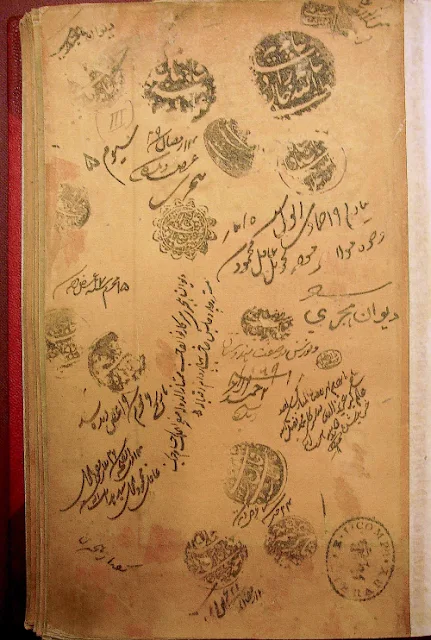Illustration for James Skinner’s entry on the “bazigar” or conjurors. Tashrih al-Aqvam. Delhi, 1825
An upright piano in the ghusal-khana (hammam) in the Red Fort, Delhi, by a late Mughal artist c. 1830–40. Traditionally, the ghusal-khana was where the Mughal emperors held their most intimate musical gatherings. Metropolitan Museum of Art, Louis E and Theresa S Seley Purchase Fund for Islamic Art, 1994
A European, probably Sir David Ochterlony, British Resident to the Mughal court 1803–06 and 1818–25, watching a nautch in his house in Delhi (c. 1820) (BL Add. Or. 2)
Detail of the royal farman (order) from Emperor Shah ‘Alam II making Mrs Plowden a Begum
Miyan Himmat Khan kalāwant, chief hereditary musician to the last of the Mughal emperors Akbar Shah and Bahadur Shah Zafar. From James Skinner’s Tashrīh al-Aqwām, Hansi (near Delhi) (1825)
Painting of Colonel James Skinner’s nautch troupe, given as a souvenir to a European visitor. Delhi, c. 1838
Preliminary leaf showing Hamidah Banu’s seal with the inscriptions and seals of subsequent librarians and owners (BL IO Islamic 791, f. IIIr)
An upright piano in the ghusal-khana (hammam) in the Red Fort, Delhi, by a late Mughal artist c. 1830–40. Traditionally, the ghusal-khana was where the Mughal emperors held their most intimate musical gatherings. Metropolitan Museum of Art, Louis E and Theresa S Seley Purchase Fund for Islamic Art, 1994
A European, probably Sir David Ochterlony, British Resident to the Mughal court 1803–06 and 1818–25, watching a nautch in his house in Delhi (c. 1820) (BL Add. Or. 2)
Asafuddowla is entertained by musicians at court. Lucknow, c.1812.
Bodhan by Kazi Nazrul Islam in the periodical Moslem Bharat (1920)
Colonel William Blair and his family in India with his daughter Jane at the pianoforte. Johan Zoffany, 1786Detail of the royal farman (order) from Emperor Shah ‘Alam II making Mrs Plowden a Begum
Hamidah Banu’s seal dated 957 1550 51 stamped at the front of the Dīvān-i Hijrī
Indian Music and Rabindranath Tagore by Arnold Bake
Inscription recording the transfer of the manuscript from the property of Nawab Maryam-Makani to Mulla ʻAli on the 12th of Mihr Ilahi year 49 (September 1604) (BL IO Islamic 791, f. 40v)Miyan Himmat Khan kalāwant, chief hereditary musician to the last of the Mughal emperors Akbar Shah and Bahadur Shah Zafar. From James Skinner’s Tashrīh al-Aqwām, Hansi (near Delhi) (1825)
Painting of Colonel James Skinner’s nautch troupe, given as a souvenir to a European visitor. Delhi, c. 1838
Preliminary leaf showing Hamidah Banu’s seal with the inscriptions and seals of subsequent librarians and owners (BL IO Islamic 791, f. IIIr)
Secret Government of Bengal Home Department Political
Spy with My Little Eye by Humphry House, Calcutta 1935
The baby Akbar and his mother Hamidah Banu Maryam Makani, from Abu'l-Fazl's Akbarnāmah. Artists Sanvala and Narsingh
The Bhagavad Gita translated by Mohini Mohan Chatterji (1887) (BL 14065.e.25)
The decorated opening of the Dīvān of Khwaja Hijri, dating from between 1556 and 1560


















No comments:
Post a Comment